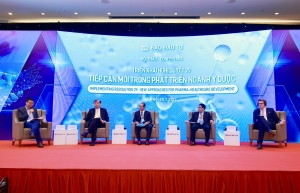Pharma innovation can come from global experience
What are the main innovation trends in the pharma-healthcare sector globally, and how does this affect Vietnam?
 |
| Trinh Van Lau, chairman of the Vietnam Pharmaceutical Companies Association |
Innovation in the pharmaceutical industry depends on the resources, science, technological capacity, and economic potential of the industry in each country.
In general, powerful pharmaceutical corporations of developed countries like Europe, the US, Canada, Australia, Japan, and South Korea focus on several main directions.
These include biotechnology, as well as tech for the preparation of controlled-release, targeted-acting drugs in cancer treatment. It also includes innovating technology for growing, processing, and extracting indigenous medicinal herbs as raw materials for the production of drugs of high economic value, thereby creating many products of national brands.
Furthermore, the industry looks to increase investment in research and production of raw materials for the production of generic drugs to ensure the security of raw materials, while harmonising the pharmaceutical industry among countries on the basis of harmonisation and mutual recognition of relevant institutions to facilitate import and export.
One of the main countries Vietnam should learn from is South Korea, which has so far made many breakthroughs in this area, and has many applied biopharmaceuticals research centres such as Celtrio, Samsung Bio, Hanmi Bio Lotte Bio, and Dong A Bio, among others.
In Vietnam, the pharmaceutical industry has made strong development steps with a high growth rate of 10.6 per cent; having 228 factories achieving GMP, including seven manufacturing facilities for vaccines and biological drugs, 51 foreign-invested factories, and 18 factories with EU GMP standards/equivalent, accounting for about 46 per cent of the total drug value and 70 per cent of the drugs used.
To achieve development targets, the pharmaceutical industry needs a revolution in innovation and thinking. We should focus on the following main directions: innovating technology for growing, processing, and extracting indigenous medicinal herbs that are valuable as raw materials for the production of drugs of high economic value; innovating in research and production of medicinal ingredients; promoting research on the production technology of special dosage forms; and renovating institutions for technology transfer for production of patented drugs, vaccines, and medical biological products.
The others are increasing investment in bioequivalence testing centres and clinical trials; establishing new research and development (R&D) centres by having suitable incentive mechanisms to call for private investment; and developing the innovative pharmaceutical industry.
What mechanisms should the sector need to promote spillover effects and competitiveness?
With the growth potential of the pharmaceutical industry and short-term and long-term goals set by the government, domestic and foreign-invested pharmaceutical enterprises have a positive outlook.
However, the lack of a clear vision of industry development and consistency in national operating mechanism has made it difficult to persuade investors and stakeholders to expand operations and investment.
These challenges are experienced by all countries in their development process. With the characteristics of Vietnam’s pharmaceutical industry in the current period, domestic enterprises can only ensure 46 per cent of the total market value and 70 per cent of the total number of drugs used on the market.
Thereby, we see that Vietnam’s pharmaceutical industry mainly produces low-value generic drugs. In order to sustainably develop the pharmaceutical industry, we need a revolution in innovation, taking science and technology as a driver, encouraging domestic private and foreign investment to contribute.
To this end, it is necessary to have consistent investment incentive policies for attracting domestic investment and foreign investment. The government, relevant ministries, and agencies should have appropriate policies to attract investment, and simplify administrative procedures in the regulations on incentives and investment attraction for enterprises and investment funds, especially multinational corporations with high scientific and technological content.
What are the expectations of your member companies about the improvement of mechanisms and policies in the pharma-healthcare sector to encourage innovation transformation?
Vietnamese pharmaceutical enterprises have been very excited to receive the attention and guidance of the government on promoting the application of science and technology as well as innovation to accelerate industrialisation and modernisation of the country.
Resolution No.29-NQ/TW and the government’s action plan to implement it is a revolution in policy mechanisms and science and technology, which has great significance for the sustainable development of Vietnam’s pharmaceutical industry, thus enabling it to become a spearhead economic sector and contributing $10 billion to the country’s GDP by 2045.
We expect new approaches in the development strategy of the industry to create a new driving forces for stakeholders to contribute more.
 | Vietnam at the crossroads: The race to secure pharma investment The first panel session, themed Vietnam at the crossroads: The race to secure pharma investment, from VIR's event Realising Resolution 29: New Approaches for Pharma-Healthcare Development on July 20 drew significant attention. The discussion centred around the quality of labour in the pharmaceutical sector and the strategic decisions that Vietnam faces in its pursuit to attract investment in this vital industry. |
 | Powering innovation for sustainable pharma-healthcare development Experts highlighted the importance of powering innovation for sustainable pharma-healthcare development at the second panel discussion at a VIR conference on Thursday July 20. |
 | Opportunities abound for innovative pharma industry Countries around the world are hoping to entice investment for their innovative pharmaceutical industries in order to bring socioeconomic benefits towards sustainable development strategies. Emin Turan, chairman of Pharma Group, talked to VIR’s Bich Thuy about the specific opportunities for Vietnam in this regard. |
 | More effort needed to increase pharma readiness Amid existing challenges and new investment approaches towards innovation and science and technology, the pharma-healthcare sector is working to tap into these trends, while developing and enhancing regulations. |
What the stars mean:
★ Poor ★ ★ Promising ★★★ Good ★★★★ Very good ★★★★★ Exceptional
Themes: Healthcare Platform
- Takeda Vietnam awarded for ongoing support of Vietnam’s sustainability efforts
- Self-care signals shift towards sustainable healthcare
- DKSH to acquire Vietnamese healthcare distributor Biomedic
- Two national hospitals expand capacity with new facilities
- Vietnam moves to enhance disease prevention, equity, and sustainability
Related Contents
Latest News
More News
- Main drivers for Vietnam’s digital economy future (December 03, 2025 | 11:35)
- Pivotal stage of growth paves way for rise in M&As (December 03, 2025 | 10:00)
- Positive projections for M&A interest from Thailand (December 03, 2025 | 09:40)
- Manifesting the first line of defence in cybersecurity (December 03, 2025 | 09:00)
- The transformational role AI can play in accounting arena (December 03, 2025 | 08:00)
- Unlocking 5G-AI potential in Singapore (December 03, 2025 | 08:00)
- Data-driven strategies vital for a fast-evolving nation (December 02, 2025 | 09:41)
- Policy to practice: how Vietnam can lead the region (November 26, 2025 | 16:03)
- Mobilising private capital at scale vital for climate battle (November 26, 2025 | 15:36)
- VILAF and Yoon & Yang launch Vietnam - Korea Practice Unit (November 26, 2025 | 15:16)

 Tag:
Tag:




















 Mobile Version
Mobile Version